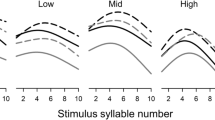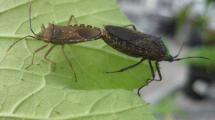Abstract
Reproduction is often more costly to females than it is to males, leading to the evolution of ornamented or competitive males and choosy females. Reproduction costs to females, however, can be reduced through nuptial gifts provided by males. These gifts, by increasing female survival or fecundity, can promote the evolution of mutual mate choice, ornamentation, or competition in both sexes, as well as plasticity in mating behavior dependent on social context. We tested for plasticity in male and female mating behavior in a species of butterfly, Bicyclus anynana, where male spermatophore gifts contribute to female survival and fecundity, and where mutual mate choice and ornamentation were previously established. We examined the effect of a sexual competitor on male–female interactions by observing and comparing the behavior of male–female pairs with that of triads containing either an extra male or an extra female. In the presence of a sexual competitor both males and females copulated less than when in male–female pairs, regardless of the direction of sex-ratio skew. Active males increased their own likelihood to copulate, while active females increased their likelihood of being courted. In addition, there was an effect of social context on relative rates of male and female courting and flying. These results suggest that both males and females change their mating behavior in response to social context in the butterfly Bicyclus anynana.




Similar content being viewed by others
References
Andersson M (1994) Sexual selection. Princeton University Press, Princeton
Ando T, Inomata S, Yamamoto M (2004) Lepidopteran sex pheromones. In: Schulz S (ed) The chemistry of pheromones and other semiochemicals I. Springer, Berlin, pp 51–96
Bateman AJ (1948) Intra-sexual selection in Drosophila. Heredity 2:349–368. doi:10.1038/hdy.1948.21
Beldade P, Rudd S, Gruber JD, Long AD (2006) A wing expressed sequence tag resource for Bicyclus anynana butterflies, an evo-devo model. BMC Genomics 7:130. doi:10.1186/1471-2164-7-130
Bergman M, Gotthard K, Berger D, Oloffson M, Kemp DJ, Wiklund C (2007) Mating success of resident versus non-resident males in a territorial butterfly. Proc R Soc Lond B 274:1659–1665. doi:10.1098/rspb.2007.0311
Bergman M, Olofsson M, Wiklund C (2010) Contest outcome in a territorial butterfly: the role of motivation. Proc R Soc Lond B 277:3027–3033. doi:10.1098/rspb.2010.0646
Bergstrom J, Wiklund C (2002) Effects of size and nuptial gifts on butterfly reproduction: can females compensate for a smaller size through male-derived nutrients? Behav Ecol Sociobiol 52:296–302
Brakefield PM, Reistma N (1991) Phenotypic plasticity, seasonal climate and the population biology of Bicyclus butterflies (Satyridae) in Malawi. Ecol Entomol 16:291–303
Cook PA, Wedell N (1996) Ejaculate dynamics in butterflies: a strategy for maximizing fertilization success? Proc R Soc Lond B 263:1047–1051. doi:10.1098/rspb.1996.0154
Costanzo K, Monteiro A (2007) The use of chemical and visual cues in female choice in the butterfly Bicyclus anynana. Proc R Soc Lond B 274:845–851
Darwin C (1871) Descent of man and selection in relation to sex, 2nd edn. John Murray, London
Davies NB (1978) Territorial defence in the speckled wood butterfly (Pararge aegeria): the resident always wins. Anim Behav 26:138–147
de Jong MA, Collins SL, Beldade P, Brakefield PM, Zwaan BJ (2013) Footprints of selection in wild populations of Bicyclus anynana along a latitudinal cline. Mol Ecol 22:341–353. doi:10.1111/mec.12114
Dewsbury DA (1982) Ejaculate cost and male choice. Am Nat 119:601–610
Dewsbury DA (2005) The Darwin-Bateman paradigm in historical context. Integr Comp Biol 45:831–837
Dukas R (2004) Male fruit flies learn to avoid interspecific courtship. Behav Ecol 15:695–698. doi:10.1093/beheco/arh068
Engqvist L, Sauer KP (2001) Strategic male mating effort and cryptic male choice in a scorpionfly. Proc Biol Sci 268:729–735
Estrada C, Gilbert LE (2010) Host plants and immatures as mate-searching cues in Heliconious butterflies. Anim Behav 80:231–239. doi:10.1016/j.anbehav.2010.04.023
Fischer K, Perlick J, Galetz T (2008) Residual reproductive value and male mating success: older males do better. Proc R Soc Lond B 275:1517–1524. doi:10.1098/rspb.2007.1455
Friberg U (2006) Male perception of female mating status: its effect on copulation duration, sperm defence and female fitness. Anim Behav 72:1259–1268. doi:10.1016/j.anbehav.2006.03.021
Gwynne DT (1981) Sexual difference theory: Mormon crickets show role reversal in mate choice. Science 4509:779–780
Johnstone RA, Reynolds JD, Deutsch JC (1996) Mutual mate choice and sex differences in choosiness. Evolution 50:1382–1391
Joron M, Brakefield PM (2003) Captivity masks inbreeding effects on male mating success in butterflies. Nature 424:191–194
Karlsson B (1998) Nuptial gifts, resource budgets, and reproductive output in a polyandrous butterfly. Ecology 79:2931–2940
Karlsson B, Wickman P (1990) Increase in reproductive effort as explained by body size and resource allocation in the speckled wood butterfly, Pararge aegeria (L.). Funct Ecol 4:609–617
Kemp DJ, Wiklund C (2001) Fighting without weaponry: a review of male-male contest competition in butterflies. Behav Ecol Sociobiol 49:429–442. doi:10.1007/s002650100318
Kokko H, Johnstone RA (2002) Why is mutual mate choice not the norm? Operational sex ratios, sex roles and the evolution of sexually dimorphic and monomorphic signalling. Phil Trans R Soc B 357:319–330. doi:10.1098/rstb.2001.0926
LeBas NR, Marshall NJ (2000) The role of colour in signalling and male choice in the agamid lizard Ctenophorus ornatus. Proc R Soc Lond B 267:445–452
Lederhouse RC (1982) Territorial defense and lek behavior of the black swallowtail butterfly, Papilio polyxenes. Behav Ecol Sociobiol 10:109–118
Martel V, Boivin G (2011) Do choice tests really test choice? J Insect Behav 24:329–336. doi:10.1007/s10905-011-9257-9
McMillan WO, Jiggins CD, Mallet J (1997) What initiates speciation in passion-vine butterflies? Proc Natl Acad Sci U S A 94:8628–8633
Melo MC, Salazar C, Jiggins CD, Linares M (2009) Assortative mating preferences among hybrids offers a route to hybrid speciation. Evolution 63:1660–1665
Nieberding CM, de Vos H, Schneider MV, Lassance J, Estramil N, Andersson J, Bang J, Hedenstrom E, Lofstedt C, Brakefield PM (2008) The male sex pheromone of the butterfly Bicyclus anynana: towards an evolutionary analysis. PLoS ONE 3(7):e2751
Nieberding CM, Fischer K, Saastamoinen M, Allen CE, Wallin EA, Hedenstrom E, Brakefield PM (2012) Cracking the olfactory code of a butterfly: the scent of ageing. Ecol Lett 15:415–424. doi:10.1111/j.1461-0248.2012.01748.x
Obara Y, Koshitaka H, Arkawa K (2008a) Better mate in the shade: enhancement of male mating behavior in the cabbage butterfly, Pieris rapae crucivora, in a UV-rich environment. J Exp Biol 211:3698–3702
Obara Y, Ozawa G, Fukano Y, Watanabe K, Satoh T (2008b) Mate preference in males of the cabbage butterfly, Pieris rapae crucivora, changes seasonally with the change in female UV color. Zool Sci 25:1–5
Prudic KL, Jeon C, Cao H, Monteiro A (2012) Developmental plasticity in sexual roles of butterfly species drives mutual sexual ornamentation. Science 331:73–75. doi:10.1126/science.1197114
Robertson KA, Monteiro A (2005) Female Bicyclus anynana butterflies choose males on the basis of their dorsl UV-reflective eyespot pupils. Proc R Soc Lond B 272:1541–1546
Rosenberg RH, Enquist M (1991) Contest behaviour in Weidemeyer’s admiral butterfly Limenitis weidemeyerii (Nymphalidae): the effect of size and residency. Anim Behav 42:805–811
Rutowski R (1980) Courtship solicitation by females of the checkered white butterfly, Pieris protodice. Behav Ecol Sociobiol 7:113–117
Rutowski R, Long CE, Marshall LD, Vetter RS (1981) Courtship solicitation by Colias females (Lepidoptera: Pieridae). Am Midl Nat 105:334–340
Servedio MR, Lande R (2006) Population genetic models of male and mutual mate choice. Evolution 60:674–685
Tompkins L, Hall JC (1981) The different effects on courtship of volatile compounds from mated and virgin Drosophila females. J Insect Physiol 27:17–21
Trivers RL (1972) Parental investment and sexual selection. In: Campbell B (ed) Sexual selection and the descent of man, 1871-1971. Aldine-Atherton, Chicago, pp 136–179
Vahed K (1998) The function of nuptial feeding in insects: a review of emperical studies. Biol Rev 73:43–78
Wedell N, Gage MJG, Parker GA (2002) Sperm competition, male prudence and sperm-limited females. Trends Ecol Evol 17:313–319
Westerman E, Monteiro A (2013) Odour influences whether females learn to prefer or to avoid wing patterns of male butterflies. Anim Behav 86:1139–1145. doi:10.1016/j.anbehav.2013.09.002
Westerman E, Hodgins-Davis A, Dinwiddie A, Monteiro A (2012) Biased learning affects mate choice in a butterfly. Proc Natl Acad Sci U S A 109:10948–10953. doi:10.1073/pnas.1118378109
Acknowledgments
We thank Robert Rak and Chris Bolick for rearing corn plants for the larvae, Natasha Kelly, Katy Prudic, and five anonymous reviewers for comments on the manuscript, and Yale University and NSF IOS-110382 Doctoral Dissertation Improvement Grant to EW and AM for support.
Author information
Authors and Affiliations
Corresponding author
Electronic supplementary material
Below is the link to the electronic supplementary material.
ESM 1
(DOCX 40 kb)
Rights and permissions
About this article
Cite this article
Westerman, E.L., Drucker, C.B. & Monteiro, A. Male and Female Mating Behavior is Dependent on Social Context in the Butterfly Bicyclus anynana . J Insect Behav 27, 478–495 (2014). https://doi.org/10.1007/s10905-014-9441-9
Revised:
Accepted:
Published:
Issue Date:
DOI: https://doi.org/10.1007/s10905-014-9441-9




